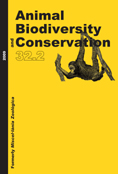A spring stopover of a migratory osprey (Pandion haliaetus) in northern Spain as revealed by satellite tracking: implications for conservation
Article Sidebar

Main Article Content
A. Galarza
R. H. Dennis
Improvements in the accuracy of satellite telemetry locations now allow detailed studies on territorial behaviour or use of habitat that can be used to enhance bird conservation. In this paper we describe the behaviour of a satellite–tracked adult female osprey (Pandion haliaetus) in the Urdaibai Biosphere Reserve (N Spain) to evaluate the suitability of this protected area for the species. The data set consisted of 10 complete days with a total of 145 exact fixes received. Night roosts were mainly surrounded by high or intermediate level protected land, separated from roads or buildings by more than 200 m and located less than one km away from the feeding area. During daylight hours, most fixes (76.5%) were located in wooded areas. We found that the bird selected holm oak woods and we suggest that this is related to low disturbance from human activity. We also suggest that northern Spanish estuaries are important as stopovers by migrating ospreys for feeding during migration.
Key words: Behaviour, Habitat selection, Migratory raptor, Protected area, Site suitability, Urdaibai Biosphere Reserve
Key words: Behaviour, Habitat selection, Migratory raptor, Protected area, Site suitability, Urdaibai Biosphere Reserve
Article Details
How to Cite
Galarza, A.; and Dennis, R. H. “A spring stopover of a migratory osprey (Pandion haliaetus) in northern Spain as revealed by satellite tracking: implications for conservation”. Animal Biodiversity and Conservation, vol.VOL 32, no. 2, pp. 117-22, https://raco.cat/index.php/ABC/article/view/144331.
Rights
Copyright
The authors retain copyright and grant the journal the right of first publication, with the work available simultaneously under a Creative Commons attribution license that allows sharing of the work with third parties, as long as they recognize authorship and the initial publication in this journal.
Most read articles by the same author(s)
- I. De la Hera, J. Arizaga, A. Galarza, Exotic tree plantations and avian conservation in northern Iberia: a view from a nest–box monitoring study , Animal Biodiversity and Conservation: Vol. 36 No. 2 (2013)
- A. Galarza, J. L. Tellería, Linking processes: effects of migratory routes on the distribution of abundance of wintering passerines , Animal Biodiversity and Conservation: Vol. 26 No. 2 (2003)
- R. H. Dennis, Landform resources for territorial nettle–feeding Nymphalid butterflies: biases at different spatial scales , Animal Biodiversity and Conservation: Vol. 27 No. 2 (2004)
- J. Arizaga, R. Garaita, A. Galarza, Leisure activities as a main threat for the conservation of waterbirds in an estuary in northern Iberia , Animal Biodiversity and Conservation: Vol. 43 No. 2 (2020)
